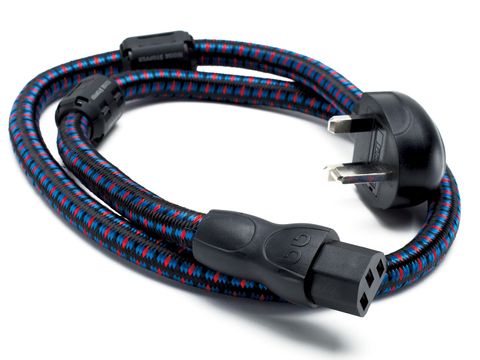TechRadar Verdict
It reduces grain, but other cables (some of which cost less) do too, without the tonal aberrations this one introduces
Pros
- +
Grain reduction
Cons
- -
Changes in tonality
Why you can trust TechRadar
We've seen plenty of chunky mains cables over the years, but few rival this one for sheer bulk. Encased within an attractive three-colour nylon-braid sleeve, it measures a whopping 13mm in diameter.
The claimed reason for the thickness is AudioQuest's 'Counter-Spiral HyperLitz' construction, an arrangement that uses several individually insulated solid-core conductors for live, neutral and earth.
One result of this construction is that the cable's capacitance is higher than most, which will cause a slight change in the characteristics of the cable/mains transformer circuit and hence, possibly, the sound compared to what you get with regular cables.
Another potentially significant factor is the use of ferrite noise absorbers near both ends of the cable. The connectors are good-quality types, and well fitted.
With suitable precautions taken against lighter pieces of kit being dragged off the shelf (this is a very springy cable!), we tried NRG-3 with several components, both sources and amplifiers. In most cases it has an effect, though it isn't always entirely beneficial.
Yes, there seems to be a reduction in grain in the sound, especially with CD players, but there's also a slight change in tonality with several components that we're not sure we entirely love.
Sounds in the lower midrange seem a little subdued, and this makes it harder to latch on to the line of melodies that use that register, as many do. It might act as a slightly unpredictable tuning tweak for systems that are a little proud in that area, but we find it oddly unsettling.
Tech.co.uk was the former name of TechRadar.com. Its staff were at the forefront of the digital publishing revolution, and spearheaded the move to bring consumer technology journalism to its natural home – online. Many of the current TechRadar staff started life a Tech.co.uk staff writer, covering everything from the emerging smartphone market to the evolving market of personal computers. Think of it as the building blocks of the TechRadar you love today.

Nikon Z 40mm f/2 review: this cheap, modern 'nifty forty' has been my every day lens for over a year and it hasn't let me down

Could ChatGPT be the next big cybersecurity worry — researchers say it can crack systems faster than ever before

Meta Quest's software is coming to new Asus ROG and Lenovo headsets
